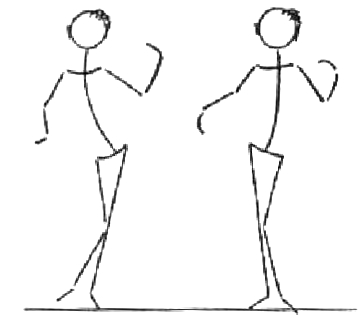|
|
Cha Cha Cha
by Irv &
Betty Easterday
The round dance world
was introduced to the "south-of-the-border" rhythms in the
mid-1970s. Many of the "old-timers" who introduced new
routines at festivals were positive that these Latins would never
become an integral part of the round dance activity. Little did they
dream that within twenty years Latin dances would comprise over half
of every round dance program. The interest that has awakened our
dance world to these exciting rhythms is phenomenal. Latin rhythms
introduced into round dancing since 1975 include swing, jive (single,
double, and triple), west coast swing, lindy, disco, rumba, bolero,
cha cha, mambo, merengue, salsa, samba, paso doble, bossa nova, and
conga.
The cha cha is an
outgrowth of the mambo as the mambo is of the rumba. The character
and floor patterns are almost identical. It is the rhythm that is
different. The cha cha is especially popular. It is gay and not quite
as subtle as the other rhythms, and it is easier to perform.
Although the cha cha is
the name of the dance, when we speak of the three steps from which
the name originated, we call them "cha cha cha." When the
cha cha cha is done, each step is a gentle slide on the floor, which
means a soft sound, not an ordinary step. Each one is done in the
rumba movement, that is, the foot placed with no weight, knee bent,
followed by the weight and the straightening of the knee. In most of
the basic steps the man holds the woman's right hand with his left.
She must maintain a certain firmness in that right arm because he
leads through it. In some cases the partners are separated entirely.
Originally, the cha cha
was done entirely on the "offbeat" -- the "2, 3, 4&1
beat." The authentic music has a very definite rhythmical link
that can be heard in each bar resulting in this "2, 3, 4&1
beat." However, as the general public latched onto the cha cha,
the rhythm of the dance changed from an offbeat to a "downbeat"
-- 1, 2, 3&4 beat." The latter was not surprising, inasmuch
as the offbeat rhythm presented technical difficulties for the social
dancer. Competitive dancers are required to maintain the "offbeat
rhythm." We, as recreational round dancers, have embraced the
"downbeat rhythm" and in so doing have discovered a feeling
of true accomplishment in this Latin rhythm.
 The music for the cha
cha is in 4/4 time, the primary accent occurring on the first beat
and the secondary accent on the third beat. This rhythm is
interpreted by the dancer with foot movements on 1, 2, 3&4;
giving a beat value of 1, 1, 1/2, 1/2, 1. Every step should be taken
with pressure on the ball of the foot, with the knee flexed, and as
the weight is taken onto the foot the heel should lower, the knee
straighten, and the heel of the opposite foot should be released as
the hips move softly sideways in the direction of the stepping foot.
This hip movement is less pronounced on steps having only a 1/2-beat
value. The music for the cha
cha is in 4/4 time, the primary accent occurring on the first beat
and the secondary accent on the third beat. This rhythm is
interpreted by the dancer with foot movements on 1, 2, 3&4;
giving a beat value of 1, 1, 1/2, 1/2, 1. Every step should be taken
with pressure on the ball of the foot, with the knee flexed, and as
the weight is taken onto the foot the heel should lower, the knee
straighten, and the heel of the opposite foot should be released as
the hips move softly sideways in the direction of the stepping foot.
This hip movement is less pronounced on steps having only a 1/2-beat
value.
The cha cha cha is an
exciting rhythm. Remember that this Latin dance, as well as its
music, is flirtatious, snappy, sharp, crisp, and fun. Enjoy! Let
yourself go!
From
clinic notes prepared for the URDC annual convention, 2000, and reprinted in the DRDC newsletter, December 2014/January 2015.

|
